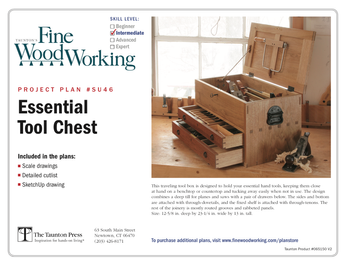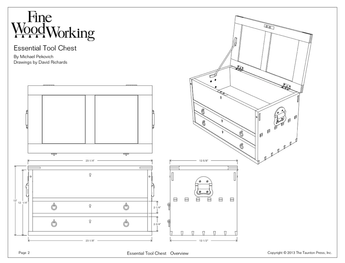Ball and claw on a Queen Anne low boy?!
Are ball-and-claw feet on a Queen Anne low boy period/style appropriate, or would purists raise an eyebrow as they would if gazing upon a digital grandfather clock? If style appropriate, should I do the B & C on all four feet or just the front? If all four, should the back two be facing forward or backwards (the case has secondary wood for the back and is intended to go against a wall).
I’m thinking about embarking on Phil Lowe’s version of the Queen Anne low boy (see Finewoodworking.com/plans), and don’t have a lathe with which to turn the feet as Phil suggests and would like to do the ball-and-claw.
Thank you . . . . Ozark Angler















Replies
Norman Vandal's book on "Queen Anne Furniture" shows a couple of variations on sculpted cabriole legs -- Spanish foot and slipper foot , pp. 24 to 27 -- that don't require turning. He doesn't mention ball and claw at all. The book's available at LV.
Jim
Oops. Vandal doesn't index b. & c., but he does show on p.39 a chair with b. & c. in front and cabriole at rear.He notes that the b. & c. is a Chippendale form on an otherwise Queen Anne chair, dated c. 1750-65.
Jim
Angler,
If style appropriate, should I do the B & C on all four feet or just the front?
Fisherman from the Ozarks: Doin the B&C on all four feet here in Knots will get you in hot water with the shed dweller from Galgate, aka Lataxe.
If you insist on all fours then just make sure they face outward at roughly a 45° angle, oooops bad choice of words.
Ah what the hey, I say go for it. If too many brows are raised jes yank 'em off an use 'em for your next piece. I never knew Queen Anne had clawed feet but then again I've lead a sheltered life.
Also, ye don't need no stinkin lathe to make the footsies, but I'd recommend ye draw a circle on the bottom of your sticks where ya want the pad to be.
Jes rough cut 'em out on the bandsaw and shape 'em with a drawknife and some files and rasps. A Four in Hand works great too.
Make 'em nice and shapely so Lataxe will like them.
:-)
Regards,
Bob @ Kidderville Acres
A Woodworkers mind should be the sharpest tool in the shop!
Edited 10/27/2008 8:44 pm ET by KiddervilleAcres
Edited 10/27/2008 8:46 pm ET by KiddervilleAcres
"Are ball-and-claw feet on a Queen Anne low boy period/style appropriate, or would purists raise an eyebrow as they would if gazing upon a digital grandfather clock?"
If this is a serious question then the answer is absolutely yes. My question to you is why do you care? If you're looking for authenticity, adding roccco ornamentation to baroque furniture isn't a a way to get it. But if the piece is already tiger maple or bubinga, who cares!
Adam
Ozark,
While ball and claw feet aren't common on what would otherwise be Queen Anne lowboys, there are some examples in the books. Sack's New Fine Points of Furniture shows two, on page 218. Downs' American Furniture: Queen Anne and Chippendale has an example, plate #323. Newport highboys seem to have either queen anne pad, slipper (pointed), or ball and claw feet, almost interchangeably. It wouldn't be out of the realm of possibility to expect to find a lowboy with the same claw feet as an existing highboy.
Trifid, or drake feet, as well as Spanish feet would also be possible choices.
As far as mixing ball and claw feet in front with pad feet in the rear, Newport pieces often employed this combination. It is not unheard of in other regions, as well.
Ray
Honest question here: What makes you think #323 is a Queen Anne lowboy? It's got carved knees, corner columns, it was built 1740-1750. It's not identified as QA.
I guess my question is, at what point does a QA lowboy become a Chippendale lowboy? They are very similar forms. The difference in my mind has always been ornamentation. And failing that, date of manufacture. This particular piece is probably a "country" version of roccoco furniture from Philly. And it was probably painted red if it's curly maple.
I think you guys are right just to point the OP to books with pictures. The terminology here is a quagmire.
Adam
Edited 10/28/2008 8:00 am ET by AdamCherubini
Adam,
"What makes you think #323 is a Queen Anne lowboy? It's got carved knees, corner columns, it was built 1740-1750. It's not identified as QA."
Tho it isn't identified as "Queen Anne", the progression of pieces throughout the book is generally from Queen Anne to Chippendale, and this piece is pretty early on in the illustrations.
The shape of the apron is typical Queen Anne. The shells are the same type as found on Queen Anne chair knees. The proportions of the case, and the drawer arrangement are more like what one would expect to find on a Queen Anne piece. Tho it has chamfered corners, they are relatively narrow
By comparison, the lower plate on the same page looks to me like a Chippendale lowboy with Queen Anne legs. The case proportions are heavier, due to the lower, busier apron, dictated by the huge central drawer which sports a rococco shell and foliage. While the legs are Queen Anne, the knee blocks have been embellished further with scrolls, the shells have pendants, and the chamfered corners are broader, with additional fluting, which contributes to the heavier feel overall. The "old fashioned" legs look too light by comparison
Of course, the progression of styles is a linear thing, advancing by fits and starts, with some makers retaining earlier stylistic elements on pieces made in "the newest fashion", and others simply adding the new ornamentation on top of the old forms they'd always made. The book was seldom closed on one style and the new chapter started with no looking back. Sometimes it is difficult, or even pointless, to assign a style to a given piece. Sometimes, the best we can do is try and place it somewhere along the spectrum. It can become a quagmire. A while back I had occasion to copy a period chair with a William and Mary base, Queen Anne splat, and Chippendale crest rail. What style would you call that?
Ray
Ray,
Nice fern.
Regards,Bob @ Kidderville Acres
A Woodworkers mind should be the sharpest tool in the shop!
More and more I'm getting the sense that these distinctions are fairly arbitrary and not in our interests to pay much attention to. The back of this chair reminds me of something William Savery would do. In fact, Savery lived long enough ago that he may have made chairs like this one. I think it's funky and kinda cool. That front stretcher reminds me of the Delaware Valley as well. Ditto for the shape of the crest rail.And it's Maple? Remember the guys from the art museum here say they've never seen a piece of maple furniture that doesn't have trace evidence of red paint on it. Maple was a popular wood for faux mahogany. Cherry was used for this too, but apparently not to the extent maple was. Adam
My current maker of interest--been kinda stuck on him--is Maj. John Dunlap. Lots o' pieces of wonderful curly Maple without paint from chairs to chests on chests. But maybe that's not what you meant.
He also has early pieces with the ball and claw for feet.
Take care, Mike
I've been reading Zea's new book about the Dunlaps with interest. Unfortunately from where I live I'll never get to see an original piece, and the photography in Zea is none-too-clear black and white. The Dunlaps certainly weren't bound by any particular tradition, and the ball and claw feet shown by Zea range from "standard Dunlap features of ducklike ball-and-claw feet" to "slender cabriole legs supported by attenuated ball-and-claw feet" so attenuated that from a distance they don't look like ball and claw. Not everyone was slavishly following the "rules" and New Hampshire isn't that far from the better-known centres. I guess the OP doesn't have to worry too much about historical period accuracy unless he's tied to a particular centre of production. I have to confess that I find some of the pieces almost ugly despite the skill of execution.
Zea spends some pages on the Dunlap formulas for paint and stain, especially the attempt to fake mahogany, and notes that a lot if not most of the paint has subsequently been removed. It would seem foolish to cover figured wood. Do you know how much unpainted furniture was produced?
For anyone interested, the book isn't the typical coffee-table pretty-picture offering, and has some useful drawings based on the work of a present-day Dunlap who works in the family tradition.
Jim
Hi Jim,
Yep, I have the Zea book as well. Written with one of the living Dunlaps, Donald. Long familial tradition. Donald's nephew was following in the family tradition until his untimely death earlier this month.
One books they used heavily is the book, The Dunlaps and Their Furniture by Charles S. Parsons. If you can find a copy, well worth it. It contains Maj. John's account books as well as Samuel's.
From what I can tell, the Dunlaps are one of the most documented makers--so many extant pieces. There are probably more unpainted pieces than painted. But there were a lot of painted stuff made. Most was stained and some actually without finish at all.
I would love to have a chance to see some, to touch some.
Well, gotta run. Take care, Mike
It's possible if not likely that the original paint finishes (which were fragile) were removed. There's a lot of reason to be skeptical of naturally finished high style maple furniture.
I have more information about this subject, if you ask me in Kentucky, I can tell you all I know in about 5 minutes flat. It's an interesting story.
Adam
I look forward to it Adam!
fwiw, the Dunlaps have been studied for such a long time that they pretty much know which were and were not painted. It's worth a look. Like the stylings of many of the details on the pieces, they didn't easily fit into a mold.
Take care, Mike
Adam,
Well, I believe that it is important to draw distinctions where possible. Arbitrary or not, it provides us with a means differentiating, and of communicating those differences.
Supposedly, the original chair had a New England history. It appeared to be unfigured maple, had most of a coat of old, brown paint on it. In The Connecticut Historical Society Bulletin (Fall '85) there is a similar chair (plate 42) with Spanish feet instead of the ball feet, identified as from Wethersfield Conn. Generic furniture of this type, with very little in the way of distinguishing characteristics can be hard to place geographically, barring a family pedigree, unlike some of the other Conn chairs which practically jump up and shout their place of origin. Other New England examples similar to this one are in Fales, Furn of Historic Deerfield, Kane, American Seating Furniture, and Sack, Fine Points. Kindig's Philadelphia Chair 's examples, by comparison have bolder "ears", applied aprons,and cabriole legs.
Sure it was common to paint or stain maple to resemble more expensive wood. Same is true for pine, poplar and others. Not sure I'd go so far as to say, always paint, and always red. For one thing, if it's trace, how's to say if it was paint (opaque layer that has been stripped), or stain (always was a transparent coating).
Ray
"Not sure I'd go so far as to say, always paint, and always red. For one thing, if it's trace, how's to say if it was paint (opaque layer that has been stripped), or stain (always was a transparent coating)."
Sorry for the paint hijack:
I think they can't tell if it was paint or stain or dye. Or at least, I recall asking and don't recall the answer (or more importantly how they knew). I asked if it could have been brick dust from some polishing, either original or done later. As i recall (and no one will tell me anything for sure) they felt that it was pigment. That may have been based on it's size and or location.
Red specifically may indicate any numbr of actual colors. Not sure if red (FeO3?) is easier to find or remains longer or whatever. So I'm saying red but the piece may have appeared brown. I think there's a "spanish brown" that was popular that had red in it.
Adam
The Zea book shows traces of red and brown on drawers that were given the two-part "mahogany treatment" -- mostly yellow birch pieces that when stained mimicked the mahogany figure. I can't see anyone using that on tiger maple, though, because it wouldn't fool anyone. And why waste the figure by using anything but stain?
Zea mentions 3 recipes for colour that survive: japanning, green, and a widely used orange that on surviving pieces has turned to pink. Yech. Personally I take oldtime colour descriptions with a pinch of salt. Until fairly recently everyone knew that the royal purple was in fact a blood red. Recently I saw a TV program on which some idiot expert went on at length about how difficult it was to alter the red dye from the shellfish used to produce it in order to make it purple. Ouch.
Jim
Ball and Claw feet aren't a uniquely Chippendale detail. In fact Chippendale The Gentleman & Cabinet-Maker's Director (at least the Dover ed. that I have) has no items with Ball & Claw feet. And Morrison Heckscher in American Furniture in the Metropolitan Museum of Art, II Late Colonial Period: The Queen Anne and Chippendale Styles shows a number of chairs that are clearly (by their proportions and structure) Queen Anne, but which have ball & claw feet.
However, the aesthetic objection to substituting ball and claw feet onto a interpretation of an original with turned "short-cut" cabriole legs with pad feet, is that you would be putting an urban high style detail onto a piece that may have the rest of the proportions and design in a more country or less formal style. You need to be sure that the general proportions and other detailing is consistent.
The wood of choice is walnut, without question, if the Queen Anne period is to be continued to be evoked. Leave the sapwood in the scrap bin, and be sure you have the proper sized stock to make the legs without glue up.
I think it's established that ball and claw feet will be fine on the lowboy. Now this being essentially a boston/connecticut piece, you need to carve the correct style of foot - if you are worried about being appropriate. The Jeffrey Greene book has a good summary of the different styles (Philly, New York, Boston, Newport are all distinctive).
Ozark,
You don't need a lathe to make a ball and claw foot. Use a band saw to cut the leg blank to shape and then refine it with a spokeshave, rasp and sandpaper. The ball and claw shape is carved.
Jim
See reply in your digital grandfather clock thread. ;-)
http://forums.taunton.com/n/mb/message.asp?webtag=fw-knots&msg=43923.1
Edited 10/28/2008 12:52 pm by RalphBarker
This forum post is now archived. Commenting has been disabled